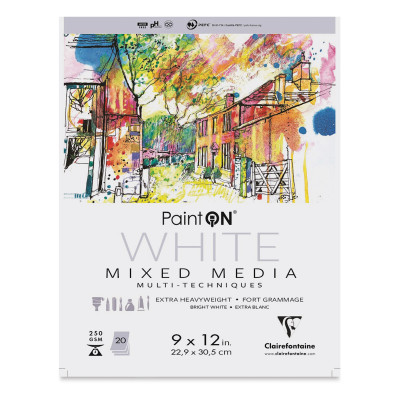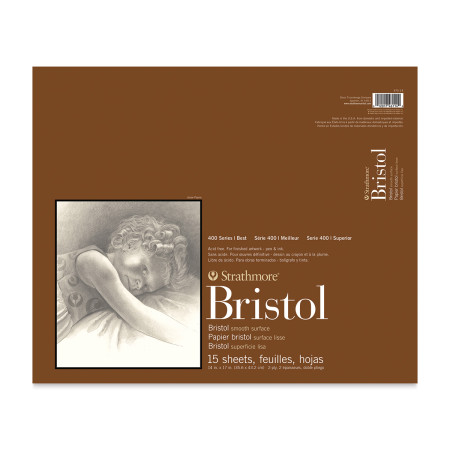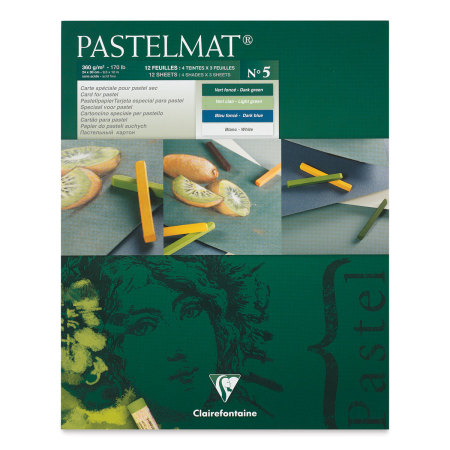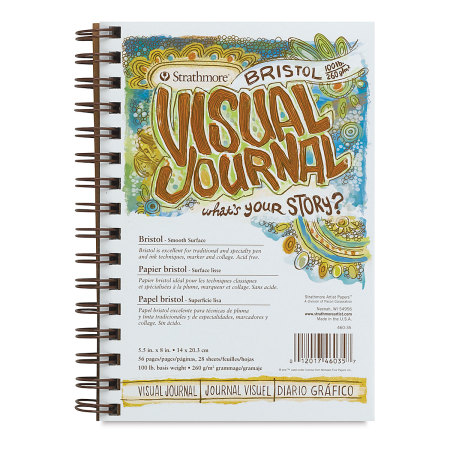Best Drawing Paper For Graphite And Charcoal
Find the best drawing paper for your chosen medium.
The type of drawing paper you choose depends on the medium you are using and your desired results. For example, if you are planning on sketching with graphite to create detailed drawings, you'll need a smooth paper. If you are planning on framing or selling your work, you'll need a thick, acid-free paper that is archival quality.
For quick sketches and doodles, it's not necessary to use the best quality paper. Practice drawing exercises and plan compositions for larger final drawings in a sketchbook so you can track your progress.
In this guide, I'll walk you through different brands and types of paper so you can choose the best one for you.
Disclaimer: Fine Art Tutorials is a reader supported site. When you make purchases through links on this site, we may earn a small commission at no extra cost to you.
Clairefontaine Mixed Media Pad

Buy here
Best for: pencil, ink, mixed media, coloured pencil, beginner or professional artists
This paper is affordable, archival quality and comes in four different colour choices. Choose the black pad for coloured pencil or pastel drawings, white or toned pads work well with charcoal and graphite.
Use with a range of media, including pastel, pencil, charcoal, gouache and more. The paper offers huge potential to experiment and get creative.
The paper resists buckling, so it is suitable for use with paint too. Try using watercolour pencils on this paper!
Clairefontaine paper sizes start at 6×8" which is the perfect size for packing away in your bag and taking outdoors to sketch.
Stonehenge Fine Art Paper
Buy here
Best for: professional artists, marker, ink, graphite, realism & detail drawing
Stonehenge pads are smooth with a vellum texture. They are superior quality, made from cotton in two different paper weights. The cotton paper has great strength and is more durable than the cellulose alternatives. The pads come in a range of sizes and each contains 15 sheets.
This is a really versatile paper due to the quality, use it with acrylic paint, charcoal, graphite, coloured pencil or even watercolour, pastel or ink. The paper is acid-free, so you can use it for professional quality final pieces. Two of the paper's edges are deckled and the surface is completely flawless. Choose from a range of colours, from tonal brown, grey, black or white. Due to the quality of the paper, it comes at a higher price point, but it's worth the investment for the feel of the paper and the quality of drawings you can achieve. You will be able to erase coloured pencil or regular pencil without damaging the surface.
Strathmore Bristol Drawing pad

Buy here
Best for: professional artists, graphite, charcoal, ink,
A smooth, thick uncoated paper board, Strathmore manufactures this paper in two different surface finishes.
Their smooth variety is perfect for fine detail work, realist drawings, fine line ink work and marker. The paper is thick enough to accommodate ink drawings without the pen bleeding through the page. The paper is 2 ply, so it has an extra thickness.
Vellum paper is also smooth, but is more suited for charcoal, graphite and coloured pencil applications. The pad is tape bound and the edges are cut clean, to make for easy removal of the sheets.

Buy here
Best for: ink, marker, detail drawing
This paper is extra smooth, with no visible surface texture, you can create smooth details. It's especially useful for marker and ink drawings and illustrations. If you plan on making copies or prints of your drawings, this paper will give you the smoothest results. It can also be used with pencil to create fine detail work. The paper is noticeably brighter than other varieties of paper, providing a more luminous surface.
The other great thing about this paper is that it is thick—at 250gsm, it is bleed proof to marker work. It's also acid-free and archival quality. Sometimes, you never know when a sketch will turn out exactly how you want it to. This paper will have your back if a drawing turns out to be your best work of art, as it will look super high quality behind a frame.
Clairefontaine Pastelmat

Buy here
Best for: professional artists, coloured pencils, pastel
This paper is specifically designed for use with coloured pencil and pastel. The texture is sanded and ever so slightly rough to the touch, allowing coloured pencil to adhere better. The thickness and surface texture of the paper allows for multiple layers of coloured pencil to be added without the need for fixative. This means that you can use a range of techniques , like creating subtle blends and fine details. Check out our tutorial for a more comprehensive guide on how to get started with coloured pencil drawing .
Strathmore Toned drawing paper
Buy here
Best for: professional artists, coloured pencil graphite, charcoal, ink,
Toned paper is a great choice for coloured pencil artists or those who want to create contrast in their drawings. The neutral backdrop enables artists to perceive value relationships more easily when drawing. You could create a monochromatic drawing with oil pencils , in Burnt Umber and White, or draw with graphite and a white pencil. Create white highlights and dark shadows, to emulate the appearance of old masters and academic artworks. This type of paper works especially well for portrait drawings.
The paper itself is fairly lightweight, but superb quality. The surface is smooth but has a slight tooth, perfect for coloured pencil applications.
The best sketchbook for drawing

Sketchbooks are convenient to have for drawing exercises, to take to an art class, or pack away and take on a trip. Use them to create thumbnail composition sketches, many professional artists will plan the composition of their painting or drawing before they start work.
Hahnemühle toned book
Buy here
Drawing on toned paper helps you to practice focussing on the values in a drawing—the relationship between the highlights and shadows. This is a lovely softcover sketchbook, the pages are lightweight and smooth.
Draw with graphite, charcoal or oil pencils for the best results. It's a thread bound book that folds out flat, allowing artists to create double page spreads and work right into the seam. The paper is bleed proof with most markers, but the pages aren't the thickest so they won't be suitable for painting with heavy watercolour washes.
Strathmore Visual Journal

Buy here
This is the ultimate sketchbook—it's great value and comes in a range of sizes and paper textures. The spiral wire binding means that you can open the book out at 360 degrees, giving flexibility while drawing. The book lies completely flat, so you can lay it out on a table or desk to work.
You can get this book in a range of paper weights up to 300gsm, which makes it perfect for most wet or dry techniques. It's a heavy duty journal and one you won't want to put down.
What kind of drawing paper is best for beginners?
For beginners or students, I would recommend a paper that is high quality but affordable. This way you get to experience drawing on professional quality materials.
Clairefontaine mixed media pad drawing paper marries the best of both worlds, as it's on the more affordable end of the spectrum, but the quality is high. If you're a beginner and not sure which drawing medium you want to use, you can experiment with any wet or dry medium on this paper.
The smoothest paper for drawing
Bristol board provides the smoothest surface for drawing. This makes it suitable for marker art, ink and fine detail drawing. The Winsor & Newton Bristol Board has no visible surface texture, giving the ability to create clean, crisp colours.
What kind of drawing paper is best for professional artists?
The best paper depends on your preferences. If you want to create smooth marker or ink drawings, the Strathmore Bristol board would be a great choice. Stonehenge Fine Art paper is a joy to work with with charcoal, graphite or oil pencil. All papers on this list are suitable for professional fine art applications.
The best drawing paper for ink
Winsor & Newton's Extra Smooth, extra thick Bristol Board is brilliant for marker and ink work and it provides the smoothest surface. Strathmore's 2 ply Bristol Board is smooth and completely bleed proof.
Types of drawing paper
Now you have an overview of some of the best brands and paper ranges available to artists, you can do some more research about the different types of paper available.
Paper thickness is important: Which gsm paper weight is best for drawing?
GSM refers to paper weight, or gram per square meter of paper. The higher the weight, the thicker the paper will be. Thicker papers are more suitable for professional applications, for drawings you want to keep and frame and for more rigorous drawing techniques.
For sketching and practising graphite drawings that you don't plan on keeping or framing, 110-130 gsm will work well. This paper weight is lightweight, cheaper and great for quick sketches that don't require much erasing. Bear in mind that if you apply lots of pressure with the pencil or do a lot of erasing, it could wear on the thinner paper.
Heavyweight drawing papers are between 160 and 260gsm. This weight of paper can support a variety of drawing techniques and mediums. Layer graphite, charcoal or coloured pencil onto the paper without worrying about denting or overworking it. With paper around 260gsm you won't have to worry about marker or ink bleeding through to the other side of the page as much. This thickness of paper is most suitable for professional applications.
Ultra heavyweight paper around 300gsm is more often used for painting, but smooth varieties will be suitable for use with marker and ink. Use ultra heavyweight drawing paper for mixed media applications, drawing and painting, or with watercolour pencils .
Gummed pads vs spiral bound pads vs stitched pads
Paper can be bought in a variety of formats. Pads usually come in either spiral bound or gummed formats.
Gummed pads of paper are glued together at one end and make it easy to tear pieces away. They're better for working on individual pieces rather than in the sketchbook format.

Buy Strathmore Visual Journal here
Spiral bound paper is better for those who prefer working in a sketchbook format. The spiral binding makes it easy to fold out pages and work flat. If you want to remove a page, look for spiral bound pads that have perforated edges so that the paper can be torn off easily.
Stitched pads are great for if you want to work on double page spreads. These are more like sketchbooks that sometimes have perforated edges.
Cotton vs cellulose paper
Cotton paper is more expensive than cellulose (wood pulp) paper, but it's more durable. Cellulose could be considered student grade paper, while cotton is considered artist grade paper. Cotton is also suitable for paint applications.
Cellulose paper is great to have around for practice pieces and composition drawings. For some people, drawing on more expensive paper can cause a certain level of creative block, as they don't want to ruin a good paper. So as a beginner, if you want to plan your pieces, do it in your sketchbook or on cellulose paper first.
Artist quality vs student quality
Student quality paper which is often cheaper, is usually more lightweight and made from cellulose fibre which isn't as durable as cotton.
If you plan on selling your work, sending it to a gallery or even if you enjoy using high quality materials, artist quality fine art paper will be a better choice. You will be able to feel a difference in the texture, thickness and durability of the paper.
What is archival, acid-free paper?
Pretty much all modern commercial drawing papers available to buy will be acid free. An acid-free paper is processed so that the lignin component that makes pulp acidic is removed. The finished product will have a neutral pH of around 7. If the lignin wasn't removed during processing, the paper would become brittle and yellow with age.
Acid-free paper is archival because it won't degrade over time. This makes it suitable for displaying artwork for years without the materials changing in appearance. An example of paper that isn't acid-free is old book paper. You'll notice if you pick up an old book, that it will have discoloured paper. This makes it unsuitable for art applications. My advice is to get a reputable range of artist grade paper for the drawings you want to keep a hold of, instead of drawing your masterpieces on any old copy paper or scraps.
To make sure your paper is archival and artist grade, all you need to do is read the product description on the art supplier website. It will usually tell you that the paper is acid-free.
If you've found anything on this site especially useful, you can make a donation to me through PayPal. I take a lot of time to research and write each topic, making sure each tutorial is as detailed as possible and I make all my content freely available. Any small donation (even the price of a cup of coffee!) can help me to cover the running costs of the site. Any help from my readers is much appreciated :).
Follow the link in the button below to support this site.
Best Drawing Paper For Graphite And Charcoal
Source: https://finearttutorials.com/guide/best-drawing-paper/
Posted by: boedingtorned1980.blogspot.com

0 Response to "Best Drawing Paper For Graphite And Charcoal"
Post a Comment